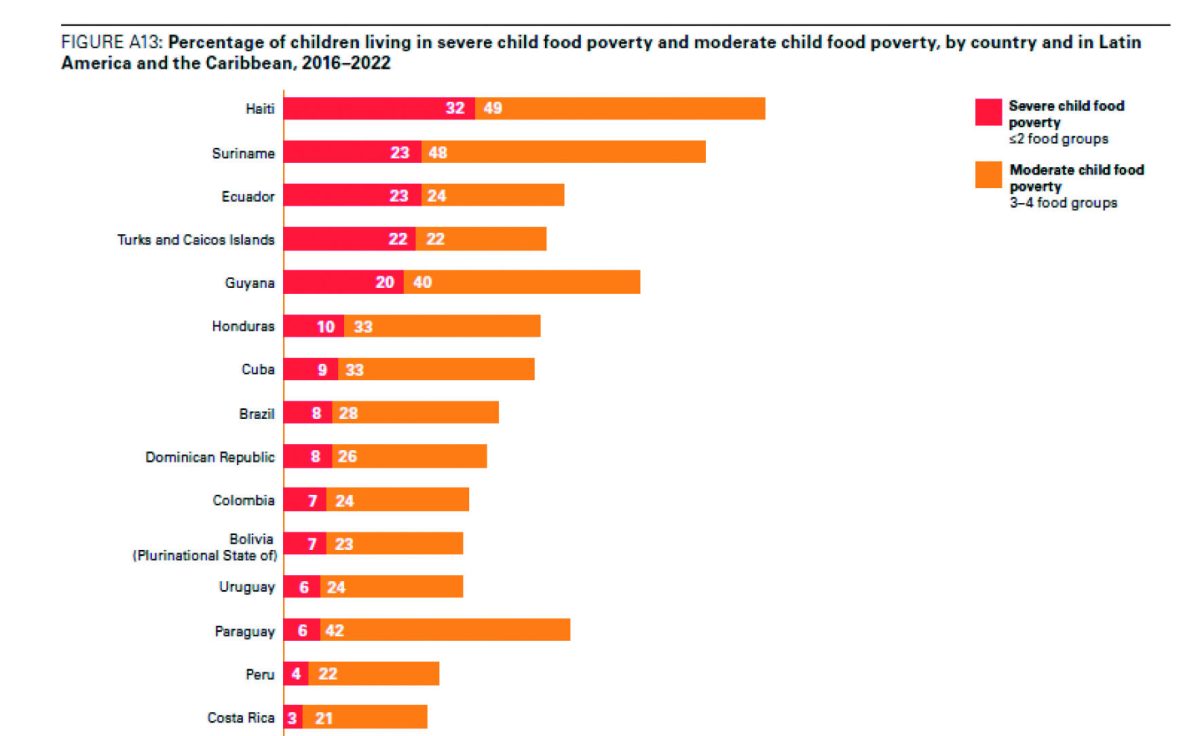-UNICEF report
Guyana is among 63 countries facing severe child food poverty, according to a recently released United Nations Children’s Fund (UNICEF) report.
According to the report some 20% of the country’s children are exposed to only two food groups daily while another 40% have 3 to 4 food groups and fall under the moderate child poverty category.
It means that a high percentage of the country’s children “are rarely fed nutrient-dense foods”. Alarmingly, these same children, according to the report, consume unhealthy foods and sweet beverages (i.e., foods and beverages high in sugar, salt and/or unhealthy fats) at a high rate, potentially displacing more nutritious foods from their diets.
Some of the country’s children have breastmilk only, dairy only or with breastmilk, a starchy staple only or with breastmilk/dairy while others access eggs, flesh foods, fruits and vegetables, pulses, nuts and seeds. There is a segment of the nation’s children that are exposed to what UNICEF refers to as “Not recommended food group”.
Sandwiched between Jordan and Bangladesh, Guyana is number 20 on a diagram that illustrates the percentage of children living in severe child food poverty, by country. The other Caribbean territories listed are the Turks and Caicos Islands, at 22, Suriname, 23, and Haiti at 32. Other regional countries like Brazil and Cuba are listed at 8 and 9 respectively. Belarus is at 1 on the list while Somalia is at 63.
The report titled ‘Child Food Poverty: Nutrition Deprivation in Early Childhood’ found that globally, one in four children (27 per cent) are living in severe child food poverty in early childhood, amounting to 181 million children under 5 years of age. The report pointed out that child food poverty harms children’s survival, growth, development and lifelong opportunities.
“Our analysis uncovers the scale of child food poverty globally, and the wide disparities in child food poverty between and within regions and countries. UNICEF’s new metric on child food poverty exposes the magnitude of the food and nutrition crisis in children,” the report stated.
According to UNICEF, globally as well, two in three children (66 per cent) under 5 are living in child food poverty. This amounts to an estimated 440 million children who are unable to access and consume nutritious and diverse diets comprising at least five of the eight food groups.
Even more troubling, the report said, 181 million of these children – more than one in four (27 per cent) – are living in severe child food poverty and surviving on extremely poor diets that include at most two food groups. These children are experiencing unacceptable violations of their right to food and nutrition at a time in their lives when the adverse impacts on survival, growth and development are most profound.
“Severe child food poverty affects all regions of the world with available data – but not equally. More than one in three children in South Asia (38 per cent) and almost one in three children in Eastern and Southern Africa (30 per cent) and West and Central Africa (32 per cent) live in severe child food poverty, compared to 13 per cent in East Asia and the Pacific and 9 per cent in Latin America and the Caribbean. Together, South Asia and sub-Saharan Africa are home to more than two-thirds (123 million) of the 181 million children living in severe child food poverty in the world,” the report said.
Further, UNICEF found that almost two thirds of all children experiencing severe child food poverty live in only 20 countries.
Giving a background to the report, UNICEF explained that it examines the status, trends, inequities and drivers of child food poverty in early childhood, including the impact of global and local food and nutrition crises. It also focuses on low- and middle-income countries, where most children living in child food poverty reside, and on the implications of child food poverty for undernutrition and poor development.
The analyses used data from the UNICEF Global Database on Infant and Young Child Feeding, comprising data from 670 nationally representative surveys conducted in 137 countries and territories, and representing more than 90 per cent of all young children globally.
Among its recommendations to address the issue globally, UNICEF suggested the elevation of child food poverty as a development priority. It was also recommended to transform food systems by ensuring food environments make nutritious, diverse and healthy foods the most accessible, affordable and desirable option for feeding young children.
It also said that the food and beverage industry should comply with policies and regulations to protect children from unhealthy foods and beverages.
UNICEF added that there should be leveraging of the health systems to deliver essential nutrition services to prevent and treat child malnutrition – including community-based counselling, support and services to improve feeding and care practices in early childhood –prioritizing the most vulnerable children.
Data systems should also be enhanced to assess the prevalence and severity of child food poverty and identify its drivers; detect increases in child food poverty early, including in fragile and humanitarian contexts; and track national and global progress in reducing severe child food poverty.






